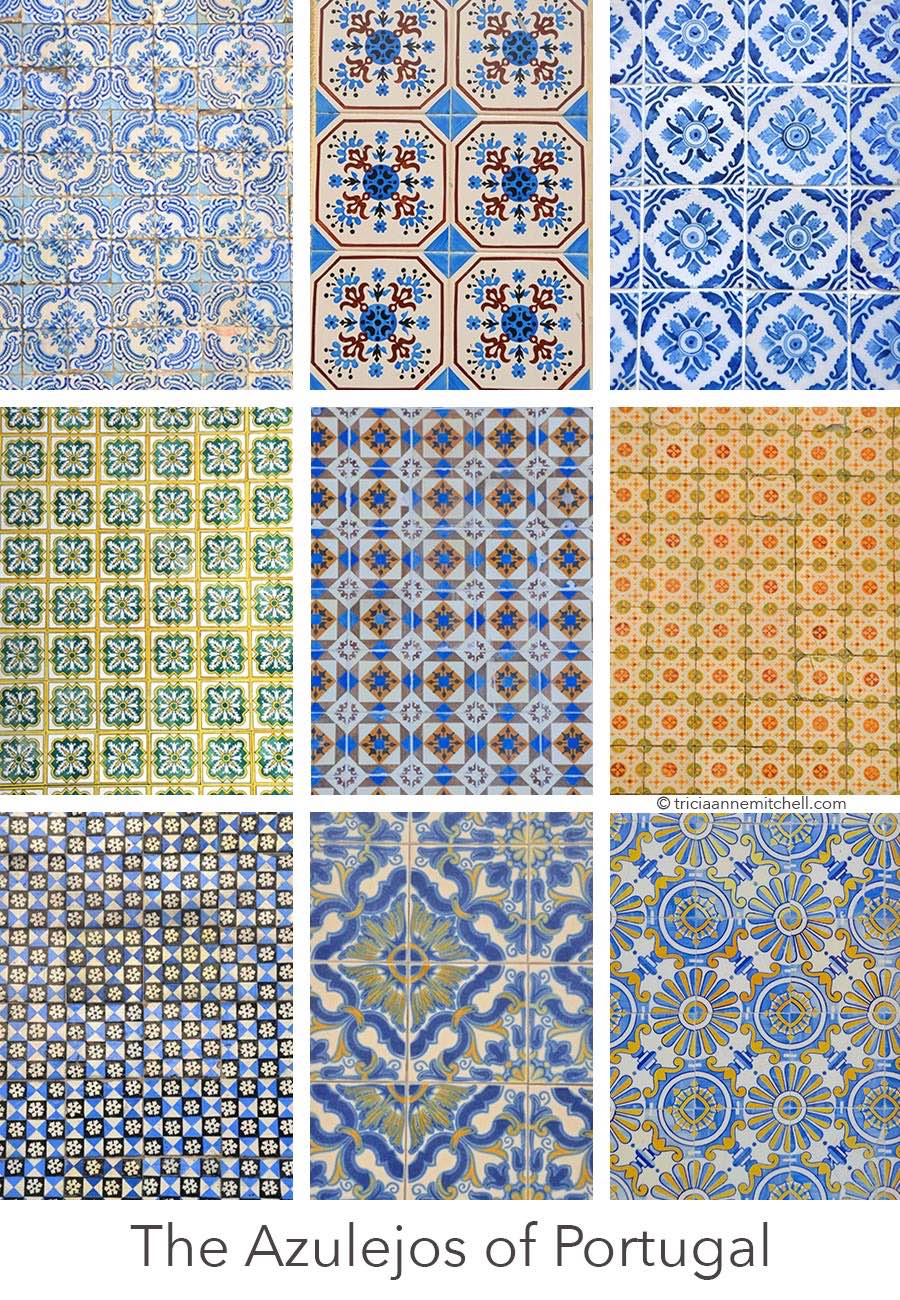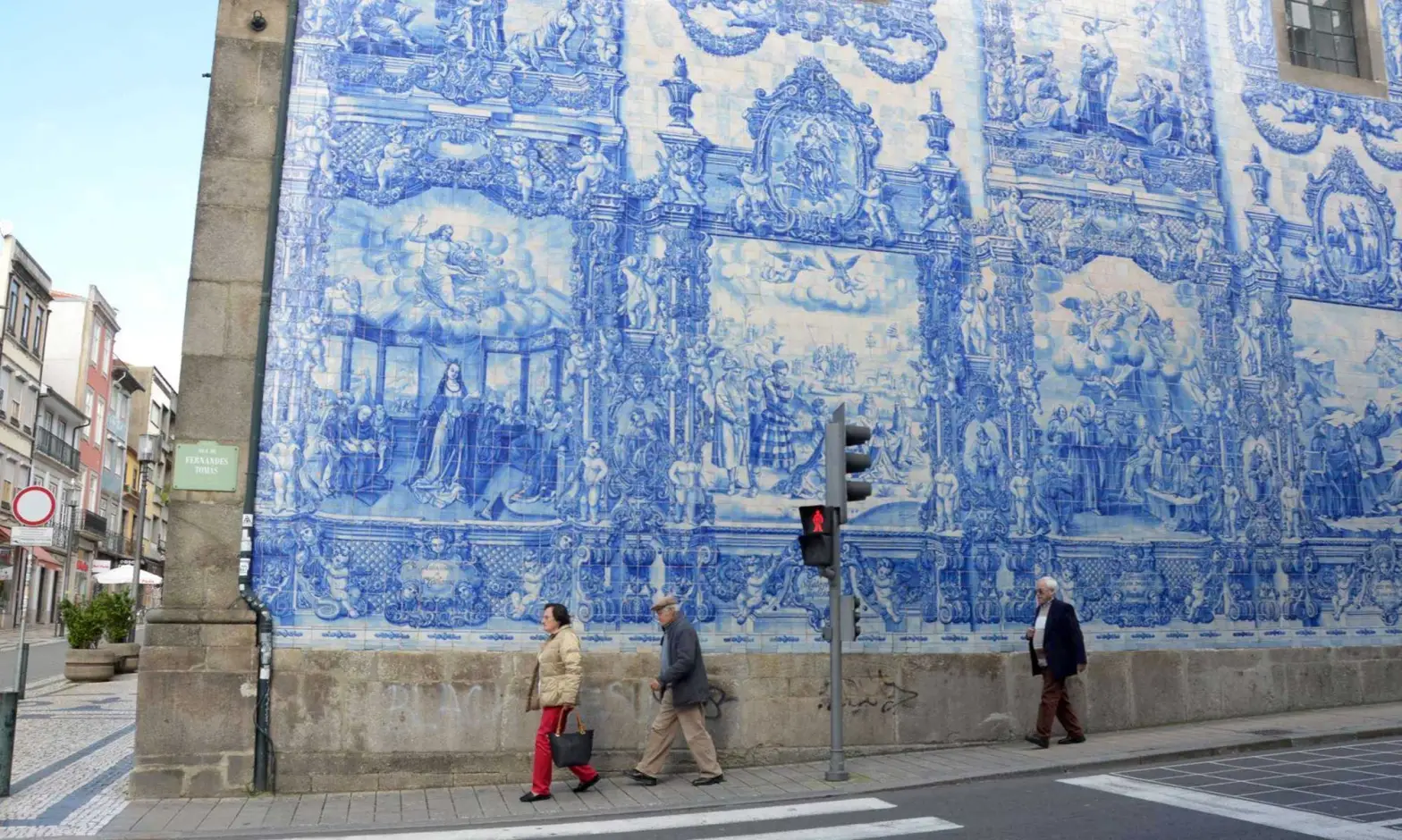Portugal is a feast for both the stomach and the eyes. It’s a land of irresistible port wine, trayfuls of crispy and creamy pasteis de nata (custard tarts), and buildings adorned with colorful ceramic tiles called azulejos.
When you visit Portugal, you’ll spot azulejos on the outsides and insides of many different types of buildings, including railway stations, churches, palaces, and even everyday homes.
Etymologically speaking, the name “azulejo” is believed to have its origins in the Arabic word, az-zulayj, which translates to “polished stone.” Originally, these vibrant tiles were created to mimic the mosaics that were perfected in the ancient Roman and Byzantine worlds.
Portugal’s eye-catching tiles are reminiscent of the colorful zellige that you’ll see in Morocco (I can’t help but think of Marrakech’s Bahia Palace) as well as in Spain’s Moorish architecture (especially Granada’s Alhambra).
In the header image above, pedestrians in Porto stroll by a photogenic church called the Capela das Almas (Chapel of Souls). The people are seemingly unaware of the fabulous splash of blue and white tiles alongside the sidewalk. Meanwhile, across the street, a small group of travelers (ourselves included!) were well aware of these enchanting azulejos.
For my azulejo collage, I’ve rounded up tiles from Porto, Coimbra, and Lisbon’s more simple buildings. Still, I think the colors and patterns are extraordinary.
Wouldn’t it be fun to have some of these beauties adorning your own home — perhaps in a garden courtyard or as a kitchen splashback?

Further Resources:
- The Best Places to See Azulejo Tiles in Porto (Portoalities – Discover Porto blog)
- The Art of Crafting Portuguese Tiles (Great Big Story video on YouTube)
- Museu Nacional do Azulejo (National Tile Museum in Lisbon)
Where in the World?
Photography & text © Tricia A. Mitchell. All Rights Reserved.

Beautiful! I’m really missing the international travel. Your posts help fill the void. <3
Hi Bobbi, I have similar feelings of wanderlust. Reflecting on our past travels helps me fill that space though. In many ways, it’s been wonderful having more time to actually “process” our past trips. So often, they were a blur.
Here’s hoping we’ll all be having more meaningful adventures in the near future. It’s hard to believe that it’s been 8+ years since we met in India!
Have you been able to explore some interesting spots in your backyard? We’ve been fortunate to have some great hiking spots nearby.
These are amazing! I worked for a German tile setter in my youth and he imported gorgeous tiles from Spain and Portugal and yes, some people had them as backsplashes in their kitchen. I have yet to visit Portugal. Perhaps when we can travel again.
Darlene, I’m intrigued — did you get a chance to learn how to install some of the tiles? As for Portugal, I hope you’ll be able to visit someday soon. (Perhaps you might even be inspired to use it as the setting for one of your next books?) Our friends had a trip planned to Portugal for earlier this year, but had to cancel. They were hoping to explore the Douro Valley, as well as a few other spots. Are there any spots in particular that you’d like to visit?
I actually took these photos in early 2019, back when we could still enjoy carefree meetings and conversations with passersby. One afternoon, we met a group of university students in a “tuna.” These female musicians wore long capes and were singing and playing traditional instruments in a park. One of the young ladies even let me wear her cape for a group photograph.
Are you still in Spain? Enjoy the rest of your weekend! :)
Yes we are in Spain and managing through it all. Miss not travelling of course. Many trips were cancelled. Paul has been to the Duro Valley on his motorcycle. A trip with his brother in 2018. I would love to visit anywhere in Portugal, it would be perfect for an Amanda adventure!! The Malta book will be released in May of 2021!
I’m sorry to hear that you had to cancel many of your planned adventures, Darlene. I know we’re all counting down the days until some degree of normal life can return. On a more upbeat note, what wonderful news that your latest book will be released in a few months! You’ll no doubt inspire others to visit Malta. Do you have another Amanda book in the works?
Yes, as a matter of fact, I am working on Amanda in France: Fire in the Cathedral. I would have gone crazy were it not for my writing during this time of lockdowns and no travel. I hope you are both doing OK. xo
That’s wonderful that you have your writing to keep your mind headed in a creative direction, Darlene. Is Notre Dame Cathedral the setting for your French Amanda book?
It´s part of it! xo
I live in a modern house, Tricia, but we do have two rather nice tile panels in the patio. I’d have more if there was space. :) :)
Hi Jo, it’s good to hear from you! I’d love to have a tiny courtyard adorned with tiles of some sort. Did you buy yours in Portugal?
Yes. There are lots of options here 🤗💕
Most beautiful colors and design of tiles. Thank you for sharing with us, Tricia. Hope you are doing well at these times.
Hi Cornelia — glad you enjoyed this peek at Portugal’s bright, cheery tiles. Like Bavaria’s Lüftlmalerei murals, they do add a lovely splash of color to an overcast day. Hope you and Moshu are having a sunny weekend!
Thank you Tricia and great to hear from you. Actually we had the first rain here since many months, what a relieve. Have a great and inspiring week, my friend.
The colors and patterns of the tiles are just beautiful!
Hi Meg, a blue and white color combo is one of my favorites, so I was naturally drawn to Portugal’s tiles too. They certainly give the buildings character.
It’s always nice to pay attention to a country’s or a place’s traditional motifs, especially when they are applied at the facades of local buildings or public spaces. Interestingly, when I went to East Timor (itself a former Portuguese colony), I saw azulejos at a church. But the entire structure was in fact constructed by Indonesia when this small country was still occupied by the former.
Hi Bama, you always share such interesting insight. How much time did you spend in East Timor? Coincidentally, my good friends just left Timor after spending a few years there. My husband was also there on a public affairs mission during the Indian Ocean Tsunami in 2004. The country sounds like it has much natural beauty.
I think I stayed for three or four nights, but that was back in 2013. I wonder how much the country has changed since then. My friend and I explored parts of its northern coast, and from what I saw natural beauty was in abundance indeed. I’d love to go back there one day.
The color and design of the tiles are looking beautiful.
Stefan, how I’d love to have some of these handmade tiles in my own home! Each one has a story, doesn’t it?